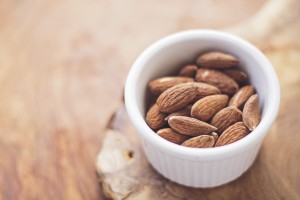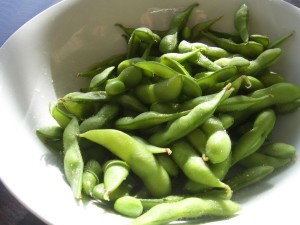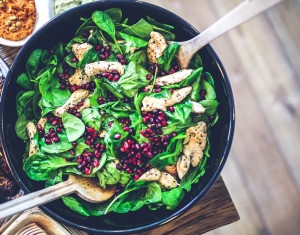 Protein definitely deserves some credit for managing to become both the most overrated and underrated nutrient simultaneously.
Protein definitely deserves some credit for managing to become both the most overrated and underrated nutrient simultaneously.
On one hand, there’s a billion dollar industry convincing anyone who sets foot in a gym that they might as well not even bother unless they’re going to have a protein shake afterwards.
On the other hand, with our dependence on carbohydrates (breakfast cereal, bread, rice, pasta, fruit), often protein gets forgotten. Including protein at each meal is one of the most common pieces of advice I give to clients who are struggling with overeating, cravings and low energy levels.
Tell me why?
Protein is used by the body to repair and build muscle, which is happening to all of us, all the time (not just body builders). It also plays an important role in filling us up and keeping our blood sugar levels more stable and appetite in check. Most of us eat plenty of protein, but often we have most of it at night or for just one meal of the day. If your diet during the day is mostly made up of breakfast cereal, bread, fruit and vegetables, followed by a big steak or chicken breast at dinner, chances are you could benefit from spacing out your protein a bit more evenly.
 Protein = satisfaction
Protein = satisfaction
Per calorie, protein is more satiating (filling) than both carbohydrate and fat. It also requires more energy (calories) to digest, so its a win/win for those looking to reduce their overall calorie intake. So by adding protein to each of your meals, you’re basically getting more bang for your buck from that meal and reducing the likelihood you’ll want to reach for a snack 1.5 hours after finishing your cornflakes.
OK, sold – where do I sign up?
The best sources of protein are meat, poultry and fish. Other good sources include eggs and dairy foods, beans and legumes (chickpeas, lentils), nuts and seeds and soy products such as tofu, tempeh.
How much do I actually need?
Not that much actually. As a general guide, you need around 0.8-1.0g per kg or body weight if you’re fairly sedentary (office job + small amounts of exercise). If you’re exercising regularly, this will increase to around 1.2-1.7g/kg, depending on gender, what kind of exercise you’re doing at what intensity and how long you’ve been training for.
Enough numbers, what does that actually look like?
70kg female office worker, light exercise = 56-70g/day
The following foods contain around 10g protein each:
Not all proteins are equal
Often certain foods are marketed as being a ‘complete’ source of protein. This basically means that they contain all of the ‘essential’ amino acids our body cannot produce on its own.
 Sorry, amino what?
Sorry, amino what?
Without getting too sciency – amino acids are the building blocks of protein. There are 20 different amino acids, of these, 9 are considered ‘essential’ because our body can’t produce them itself so needs to get them from our diet. Most animal sources of protein contain all 20 amino acids, however, most plant proteins lack at least one, so it’s a good idea to consume a range of different plant proteins. Some examples of ‘complete’ plant proteins are quinoa and soy.
Protein supplements 101
The best sources of protein are whole, minimally processed foods in as natural a state as possible – meat, eggs, dairy products, nuts, seeds and legumes, as we’ve covered. But that’s not to say there’s no place at all for protein shakes and other protein supplements.
If you’re doing a lot of resistance training and lifting heavy weights your protein requirements will be elevated. Insufficient protein or overall energy = minimal muscle growth. It’s best to get this extra protein from food, but it’s not always convenient to tuck into a steak right after the gym. So, in some cases, protein supplements can be a good option from a convenience perspective, just don’t be fooled into thinking that they’re a ‘health food’. At the end of the day its another highly processed food that wouldn’t recognise its original food source (milk? soy beans? rice?) if it smacked it in the face. They also often have a lot of artificial ingredients added which our bodies don’t need (although it is possible to make your own ‘protein shake’ without protein powder).
And remember, simply taking protein powder or eating protein bars won’t magically make you build muscle or tone up – you need to be giving your body a reason to change first through good old fashioned exercise.
What happens if I eat more protein than I need?
Your body can’t store excess protein – but if it’s not needed for muscle building and repair, it can be used as fuel instead. If you’re just getting protein from food and not supplementing, the risk of eating too much is low in a healthy person. If you’re downing protein shakes and bars on top of a normal diet, you might be overdoing it.
So what should I eat?
Aim to include some protein in each of your meals, for example:
Breakfast
Cereal? Add some yoghurt (Greek yoghurt is higher in protein than other yoghurt) and have it with milk
Toast? Have it with peanut butter or top it with an egg
Smoothie? Add some milk or soy milk, yoghurt and chia seeds
 Lunch
Lunch
Sandwich? Add some chicken, tuna or roast beef or egg
Salad? Add some beans or chicken/tuna
Pasta? Go for one with some meat or fish
Sushi? As above
Dinner
Meat and veg? You’re sorted
Pasta? Add some meat or fish
Salad? Add some beans, egg, tofu, meat or fish
P.S – despite its bad rap as the most evil of the carbohydrates, bread can contain a decent amount of protein if you go for the right kind. Two slices of multigrain bread can have up to 12g protein!
So, take home message? Protein is your friend, so try to include some in the majority of your meals. And finally, eat real food when you can, supplement if you must – easy!
If you want individualised advice about your protein needs, or you have any other nutrition concerns, we would love to help.

Leave a Reply